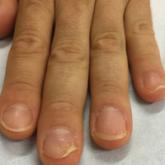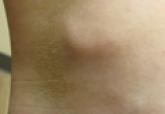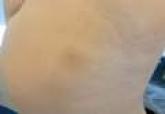Practical Pearls

Clinical Pearl: Early Diagnosis of Nail Psoriasis and Psoriatic Arthritis
Psoriatic arthritis (PsA) is more common in patients with nail psoriasis. Radiograph imaging is a quick, inexpensive, and valuable diagnostic...
Drs. Wu and Rubenzik are from the Department of Dermatology, Houston Methodist Hospital, Texas. Drs. Goldberg and Zelickson are from Dermsurgery Associates, Houston, Texas.
The authors report no conflict of interest.
Correspondence: Wesley Wu, MD, Houston Methodist Hospital, 6565 Fannin St, Houston, TX 77030 (wesleyw96@gmail.com).

This article describes the various applications of the flexible scalpel blade (FSB), the utility of the banana as a convenient and exceptional training instrument, and the intricacies of mastering the technique for students of different training levels.
The flexible scalpel blade (FSB) is a 2-sided handheld razor blade that serves as a pivotal instrument in certain dermatologic procedures. Its unrivaled sharpness1 permits pinpoint precision for shave biopsies, excisions of superficial lesions,2 scar contouring, and harvesting of split-thickness skin grafts.3 Given its flexibility and long edge, considerable manual dexterity and skill are required to maximize its full potential.
Prior to practicing on live patients, students on clinical rotation would benefit from in vitro skin simulators to practice correct hand position, FSB control for concave and convex surface cutting, and safety. Prior practice models have included mannequins, tomatoes, and eggplants.4,5 Here, the authors recommend the use of a banana (genus Musa). In addition to its year-round availability, economic feasibility, simplicity, and portability, the banana has colored skin that well represents the epidermis, dermis, and subcutaneous tissue, allowing for visual feedback. Furthermore, its contour irregularities simulate convexities and concavities for various anatomic locations. Although the firmness of a yellow-green banana provides immediate tissue feedback, the softness and pliability of a ripe banana simulates the consistency of older skin and the use of appropriate traction.
To begin, one simply requires a marking pen, banana, and razor blade. Various shapes, including a circle, ellipse, rectangle, trapezoid, triangle, and multilobed lesion are demarcated by students or attendings (Figure 1). Careful removal of the pieces helps students improve dexterity, develop feel for the entire edge of the razor blade, and acquire muscle memory for these skilled movements (Figure 2). Three-dimensional spatial reasoning is honed with practice using the FSB to control appropriate thickness and defect depth while creating a smooth bevel around the entire perimeter, which is important for optimal cosmesis in second intention healing or grafting. The shallower the defect created, the faster the healing and the greater the reduction in contracture. Although downward pressure is important to prevent buttonholing or tearing of the tissue being removed, the angle of the blade relative to the tissue must be assessed at all points, and the alteration in color and fiber orientation signify change in depth of the banana peel.
To handle the FSB, one can hold the lateral edges of the blade between the thumb and index finger or between the thumb and middle finger. The thumb and index finger position allows for additional flexible working space and visualization, increased traction by the remaining 3 fingers, and greater ease of removal of lesions with considerable height. The thumb and middle finger hold allows for versatile use of the index finger of the same hand for stabilizing the center of the blade, fixing the tissue on the FSB while it is removed, and sliding the specimen off the FSB. It is important to maintain a fixed distance from the blade to the metacarpals at all times to ensure smooth advancement of the blade and visualization. Beginners can lift the pinky finger of the hand holding the FSB and move the finger up and down to control the angle of the blade.
Generally, we utilize various techniques of shaving using the FSB. We approach the target lesion 2 to 3 mm from the marked location and slide parallel to the skin surface and perpendicular to the lesion until the epidermis is penetrated. Second, we advance the blade toward the lesion with careful attention paid to the perimeter of the lesion and the points of contact of the FSB. For lesions with hardier consistencies, a sawing motion of the blade is employed, which also requires controlled tilting of the wrist to maintain an even depth and smooth bevel. To cut deeper, flexing the FSB with lateral pressure is helpful. More shallow lesions require the instrument to be flatter and less bowed. When finishing the shave, it is important to start angling the blade upward early, either at the center of the targeted lesion or 2 to 3 mm before the demarcated edge of the skin graft, while applying traction away from the lesion and slight downward pressure with the nondominant hand.
For larger lesions, the perimeter may be more difficult to remove precisely and can be achieved by rotating the blade around the lesion with focus on one point of contact of the FSB to cut and glide through the tissue’s perimeter. To achieve a more exact wound edge and to preclude jagged borders, a No. 15 blade can be used to score the perimeter very superficially to the papillary dermis prior to shave removal. The main disadvantage, however, is that the beveled edge is removed.
In summary, the FSB is an exceptional tool for biopsies, tumor removal, scar contouring, and split-thickness skin grafts. Through the banana practice model, one can attain fine control and reap the benefits of the FSB after meticulous and dedicated training.

Psoriatic arthritis (PsA) is more common in patients with nail psoriasis. Radiograph imaging is a quick, inexpensive, and valuable diagnostic...

Alcohol can be used as a diagnostic aid for patients with dyschromia commonly seen in terra firma-forme dermatosis, confluent and reticulate...

Plantar warts can be distinguished from calluses using the squeeze maneuver, a quick and easy method to diagnose plantar warts. This technique...
